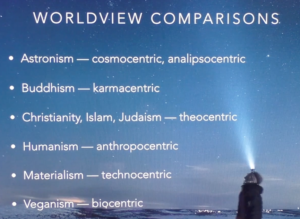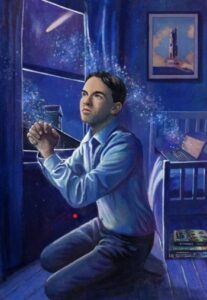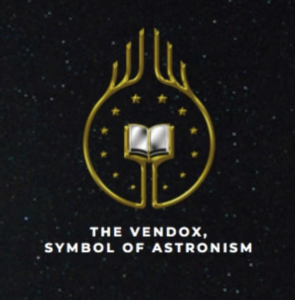ASTRONISM TIMELINE
1998: Brandon Reece Taylor (Cometan) was born in Preston, United Kingdom.
2013: Cometan began receiving intense revelations. On, the Astronic calendar, this is known as the “Year of The Gift” when Cometan had the idea to create a fictional detective character (Jesse Millete), which eventually expanded and culminated in the creation of Astronism itself.
2014: Cometan completed his education from Brownedge St. Mary’s Roman Catholic High School in Bamber Bridge. He then studied for two years at Preston’s Cardinal Newman College, graduating with three A levels.
2016: Cometan commenced work on a Bachelor Degree in Business and Marketing at the University of Central Lancashire. Midnight on the first of July became known as the Dedication of Cometan or the Great Dedication; it was also the beginning of The Year of Expansion, signalling the fourth year since The Founding of Astronism.
2019: Astronism claimed more than 3,500,000 global adherents (0.04% of the world’s population). Cometan celebrated twenty-first birthday at a large-scale event.
2020: The Concise Dictionary of Astronism was published by Astral Publishing. Cometan completed his Master’s Degree in Religion with a dissertation on his theory for an Astronic tradition.
2021: Cometan published The Institutional Dictionary of Astronism.
2021 (June 16): Cometan published The Institutional Dictionary of Freedom of Religion and Belief and marked the mid-point of his PhD research that promoted the “Cometanic freedom of religion theory.”
2023: Completion of Cometan’s PhD dissertation under the name of Brandon Reece Taylorian is expected.
FOUNDER/GROUP HISTORY

Brandon Reece Taylor (later Taylorian) [Image at right] was born on July 1, 1998 in Preston, United Kingdom. Following the Year of Ignorance (2014), from the age of seventeen during his Year of Enlightenment (2015), Cometan began to write down his experiences of intense inspirations and revelations known as “the Founding of Astronism” and culminating in his record-keeping book Omnidoxy. In November 2016 (the Year of Expansion), while at the Royal Albert Hall in London with his grandparents, Cometan experienced a series of intense revelations and ideations. In December 2016, Cometan founded The Social Sorcerer Company that would later become the marketing agency for both the Astronist religion and his Spacefaring World franchise.
Beginning in February 2017 (the Year of Consolidation), Cometan began his first long-term relation with Liana Tiratsuyan (Cosma), an Armenian student living in Yerevan who became Cometan’s first follower and historically the second Astronist. This was the year in which Brandon Taylorian adopted the name Cometan for his public persona as a philosopher. In April, as part of the University of Central Lancashire’s Journey to the East programme, Cometan travelled to Beijing, China where he encountered Chinese religion and philosophy, which became noteworthy influences on the development of his Astronic thought. On May 6, he published his first magazine article (in Lancashire and North West) covering Astronism and his Jesse Millette books.
2018 is known as the Year of Prolifics. In November, he organised the first astronomical event (Stargazing at the Tower) at the walled manor house of Hoghton Tower in Preston. In June of 2018 and at the same venue, Cometan celebrated his twenty-first birthday with a lavish party for friends and family.

In 2019, (the Year of Completion), Cometan graduated from UCLan with a first-class honours degree, placement on the Dean’s List and the CMPR Divisional Prize for Best Project award. In August, he travelled to Hong Kong to meet Huang Xiangdong (Heastward), [Image at right] who has become instrumental for the establishment of the religion in the Sinosphere, and Mai Kaijian (colloquially MK), friend and “the second follower.”
From the first of July of 2020 (the Year of Manifestation) and coinciding with the COVID-19 pandemic and lockdowns, the Astronist Institution has been severely challenged and required to cancel many of its plans. As a consequence, Cometan began his video series, “A Conversation with Cometan” (e.g., “A Conversation”). In 2021, Cometan released the global demographics (estimated membership) of Astronists (Cometan 2021a). In a more recent interview (Tripoli 2021), he allows that at present followers number in a few thousand, maybe more. With regard to the Astronist freedom status, with the exceptions for the Vatican City, Northern Cyprus, Jersey, Guernsey, Saint Martin, the Åland Islands, Saint Berthélemy, Montserrat, the Cocos (Keeling) Islands and Somaliland, each of the world’s countries and territories has been classified as either apathetic, censorious or terminal. During 2020, the Grand Astronist Archives was established with more than 138,000 articles.
DOCTRINES/BELIEFS
The principal belief of Astronism is that humanity is not fulfilling its intended purpose. It is only through the physical and spiritual exploration of the cosmos that true existential achievement will be attained. Outer space represents the place where humanity will find answers and become elevated to what is presently still unfathomable.
Astronism is described by Cometan as a naturalistic astronomical religion focusing upon “cosmic contemplations” of space and the stars for its spirituality, faith, destiny, hope, future and existential purpose. The core of Astronism is its cosmic philosophy (cosmontology) that concentrates on the nature, form, structure, past and future destiny of “The Cosmos.” There are three additional Religious Astronist components that concern supernatural belief as well as eschatological, theological and soteriological thought: transhumanism (the belief or theory that the human race can evolve beyond its current physical and mental limitations, especially by means of science and technology), trancensionism (the achievement by humanity of unprecedented intellectual, physical, religious and mental heights through space exploration) and transtellationism (the eschatological school of thought advocating supernaturalism, especially centring on the idea of reunion with The Cosmos upon death). Broadly, Astronism comprises belief in cosmosis (the post-mortem becoming one with the cosmos) and astrosis (corporeal cosmosis or this-life engagement with and knowledge of astronomical mysteries) but extends into sentientism (belief in the existence of an abundance of life and intelligence in the cosmos) and intracosmism (which Cometan explains as the belief that the answers to existential questions are to be found within the cosmos rather than beyond it). Although belief in deity or a deity is left to individual choice, divinity (The Divine) is to be understood as “the ‘uncaused first cause’ that sustains, but crucially, did not create The Universe.” The cosmocentric stress of Astronism, however, is upon the non-theistic study, understanding and exploration of the cosmos as of physical, spiritual, mystical and intellectual importance.

Cometan considers Astronism to be the modern manifestation of the series of astronomical religions that began in the Upper Paleolithic period. [Image at right] Accordingly, it belongs to the Astronic tradition that today co-exists with the Abrahamic, Dharmic and Taoic [sic.] traditions (Cometan 2020), a classification of religions that compares with York’s ideal types of religion as Abrahamic, Dharmic, Pagan and Secular (York 2019:6-8). However, as a possible fifth Weberian social science construct, namely, the Astral or Galactic (York 2003:204), Astronism may be seen to have similarities to some extent with both Scientology and Raëlianism. While Raël (Claude Vorilhon) claims direct contact with the extraterrestrial Elohim (“those who came from the sky”) and L. Ron Hubbard held that a human’s immortal thetan or spiritual being previously existed extraterrestrially, Cometan affirms the existence of life throughout the universe but does not appear to have been in direct physical contact with conscious entities from beyond the earth. Instead, his revelations and ideations seem to have a greater affinity with the kind of spiritual mediumistic visions of people like Helena Petrovna Blavatsky, Alice Bailey or Edgar Cayce.
In contrast to the sect-like characteristics of Scientology (firm boundaries, possibility of expulsion for heresy), Astronism, though also “deviant” from the perspective of the religio-spirtual beliefs of the host societies in which it finds itself, conforms more to Roy Wallis’ understanding of the cult in his church-sect-denomination-cult typology of religious collectivities (Wallis 1975:90). However, Cometan considers the non-sociological and negative understanding of the cult as that which is to be contrasted with “a genuine NRM” (new religious movement) in its terms of manipulation and control of its followers by the group’s leader. In an interview, he denies to Sam Tripoli that Astronism is a cult, and while acknowledging Scientology’s cult-behaviour in this harmful sense, he sees the movement as closer to being a science as well as “a corporate enterprise straddling the fence between the sacred and the commercial” (Cometan 2 020).
020).
RITUALS/PRACTICES
Astronists are encouraged freely to use the example of the July 1 Dedication of Cometan [Image at right] to ignite and augment their own journeys to astrosis and transcension of humanity as well as to its secular employment toward alleviating personal hardships and suffering in this life. Further, adherents study the annual life periods (each single year of Cometan’s life beginning with July 1) that have organised the events of his life, each labelled by an overall dominant theme (e.g., The Year of Prolifics) (Cometan n.d.)
For followers of Astronism, key astronomical events are celebrated. For instance, Cometan in his annual Stellara Statement hails the Winter Solstice of 2020 as both the peak of darkness for the northern hemisphere and the mark of a new beginning. So weather permitting, he asked his followers “please don’t forget to peer up to the stars this evening alone or with loved ones to marvel at The Cosmos, of which we make up such a small and insignificant part” (Cometan 2021b).
ORGANIZATION/LEADERSHIP
While both Scientology and Raëlism are “universally mocked” in wider society (e.g., Palmer 2004:15), the question arises concerning the charismatic leadership in astral and other NRMs. The term “‘charisma” is applied by Max Weber
“to a certain quality of an individual personality by virtue of which he is considered extraordinary and treated as endowed with supernatural, superhuman, or at least specifically exceptional powers or qualities. These are such as are not accessible to the ordinary person, but are regarded as of divine origin or as exemplary, and on the basis of them the individual concerned is treated as a ‘leader’. […] How the quality in question would be ultimately judged from any ethical, aesthetic, or other such point of view is naturally entirely indifferent for purposes of definition. What is alone important is how the individual is actually regarded by those subject to charismatic authority, by his ‘followers’ or ‘disciples’” (Weber 2013:241f).
Cometan clearly possesses both the persuasive charm and energetic dedication to motivate others, but he denies seeking the kind  of control exercised by Hubbard or Raël. in which Cometan makes clear that his wish is simply to discuss transcension/existential salvation with others (Tripoli 2021). He says, “This is why I believe in destiny because I can’t honestly say that I think that my comprehension of the astronomical world and my founding of Astronism in this very moment in history are coincidental as that seems utterly implausible. No, instead, I believe that the force driving me forward to recombine astronomy with religion as a testament to the original religion of prehistoric Astrolatry [Astronism’s ‘Emotional Basis’], is the same force that drives all other change in The Cosmos, both minute and monumental” (Cometan 2020). [Image at right]
of control exercised by Hubbard or Raël. in which Cometan makes clear that his wish is simply to discuss transcension/existential salvation with others (Tripoli 2021). He says, “This is why I believe in destiny because I can’t honestly say that I think that my comprehension of the astronomical world and my founding of Astronism in this very moment in history are coincidental as that seems utterly implausible. No, instead, I believe that the force driving me forward to recombine astronomy with religion as a testament to the original religion of prehistoric Astrolatry [Astronism’s ‘Emotional Basis’], is the same force that drives all other change in The Cosmos, both minute and monumental” (Cometan 2020). [Image at right]
ISSUES/CHALLENGES
The prominent concern for Cometan is the extension of human rights (the Universal Declaration of Human Rights) into space exploration, spacefaring activity, space tourism and extra-terrestrial settlement, namely, the adoption and implementation of a “Convention on the Rights of the Person in Outer Space” (CRPOS). Cometan’s doctoral studies are focused on hegemonic abuse and the governmental control of citizens’ identities. The proposed dissertation title is “Do Recognitory and Commercial Restrictions Imposed on Religious Organisations Cause Impediments to Freedom of Religion?”
Another issue that has developed from the Astronic endeavour to re-cement Astronism as the (ultimate) culmination of millennia of astronomical religious influence manifested as a singular religion and the re-integration of religion and science relates to Ayres’ (1996:174) concern with
the possibility of the reintroduction of the sacred into sociology as a basis of religious belief and to the need for categories which will help in providing a nuanced description of the place of self.
Following Robbins (1940:3), Cometan relates the absence of an Astronic tradition from current religious scholarship with “the divergence of astronomy from religion after the discoveries of the Age of Enlightenment, particularly the disintegration of astronomy from astrology” (Taylor 2020:27). He argues that astronomically based religion is the oldest of spiritual traditions, but this overlooks that for the earliest of human origins, at least as far as we can discern, the root of religion is pagan in as much for the ancients, Heaven and Earth were perceived at best as equal expanses and hence with as much reverential connection to sacred springs, venerable trees, the elements, mountains and other geographic phenomena as to the sun, moon and moving stars, etc. Our planet’s infinitesimal size vis-à-vis the incomprehensible enormity of the cosmos itself is only a later discovery. Nevertheless, Cometan’s efforts echo the frequent reconnecting of the religious and scientific that is occurring in the twenty-first century, one that Johnston, for example, perceives in questions about the future which increasingly “help to manufacture a highly affective mode of … communication [that] is inevitably tied to religion somewhere within the web of significations provided as answers” (Johnston 2013:184).
The intention behind Cometan’s naturalistic astronomical religion is to resecure a spiritual understanding of the cosmos without simultaneously eschewing empirical investigation but instead precisely to employ technological developments to this end. Nevertheless, as Hillman (1999: 56f) indicates, the practical instrumental approach prevails in the young in contrast to the preference of the elderly “for deliberative reflections, often metaphorical and meditative … beyond the models and attitudes of science.” Inasmuch as “‘Cosmos’ indicates a world formed by aesthetics, … [the] aesthetic imagination is the primary mode of knowing the cosmos, and aesthetic language the most fitting way to formulate the world” (Hillman 1999:184).
Nevertheless, the American psychologist would virtually seem to have someone like Cometan in his thoughts when he refers to the mind as naturally curious, inventive and transgressive.
One further challenging issue to date involves the minimal amount of non-Cometan sources for information on and assessment of Astronism. However, due to the relative novelty of the movement since its founding in 2012 and the youth of its founder, this lacuna is expected eventually to change. Nevertheless, while acknowledging Cometan as a “young prodigy,” Braley Heinley criticises Astronism in that “it does not particularly give a rite of passage into how humanity should live and what people should think and how we should react in certain situations” (Heinley 2021). In his article on “Astronism, and Space Renaissance,” The Civilian Space Protocol’s Adriano Autino recognises the humanistic philosophy of the latter and the non-theistic religiosity of the former (Autino n.d.).
In time, of course, researchers will be able to witness the charismatic development, the kind of “holier than thou” attitude that can appear with a religious leader and/or any possible lack of objective perspective to emerge with the institution’s creator. La Barre wonders if the recognition of a true messiah depends solely on historical hindsight. In the present, he allows that “a new leader’s conviction must rise sometimes to paranoid heights to be heard” (La Barre 1972:614). If this is to be the case with Cometan, it is yet to be seen. When asked by Tripoli how would Astronism help him in his own life today, Cometan answers that through the taking of a more existential perspective, one can come to see the bigger picture. Vis-à-vis the universe, humanity is a part, but it or the self is not the centre. What Cometan explained to Tripoli is that what he is trying to promote for others is simply to look up at the stars and relate that to one’s beliefs and identity.
IMAGES
Image #1: Brandon Reece Taylor (Cometan) on his twenty-first birthday.
Image #2: Cometan and Heastward visiting the Tian Tan Buddha in Hong Kong.
Image #3: Cometan’s Worldview Comparisons.
Image #4: Dedication of Cometan, David Young.
Image #5: The Astronism logo.
REFERENCES
“A Conversation with Cometan & Professor Michael York.” 2021. Accessed from https://www.youtube.com/watch?v=qjxO-YI7KAI on 25 September 2021.
Autino, Adriano. “Astronism, and Space Renaissance.” Accessed from https://spacerenaissance.space/astronism-and-space-renaissance/ on 25 September 2021.
Ayres, Lewis. 1996. “Theology, Social Science and Postmodernity: Some Theological Considerations.” Pp 174-89 in Postmodernity, Sociology and Religion, edited by Kieran Flanagan and Peter Jupp. London: Macmillan.
Cometan. 2021a. Demographics of Astronism Report 2020. Accessed from https://cometan.medium.com/demographics-of-astronism-report-2020-9f84ae5c4938 on 20 September 2021.
Cometan. 2021b. “Scientology: Cult, Science or a Corporate Enterprise?” Accessed from https://www.researchgate.net/publication/344225458_Scientology_Cult_Science_or_a_Corporate_Enterprise on 25 September 2021.
Cometan. 2020. Astronomy and Religion Journal 1.1:2-4 (2 September).
Cometan. n.d. “Annual Life Period.” Accessed from https://astronism.wikia.org/wiki/Annual_life_period on 20 September 2021.
Heinley, Braley. 2021. “Philosopher of the Stars.” Accessed from https://www.researchgate.net/publication/351372735_Philosopher_of_the_Stars on 23 September 2021.
Hillman, James. 1999. The Force of Character And the Lasting Life. New York: Random House.
Johnston, Lucas F. 2013. Religion and Sustainability: Social Movements and the Politics of the Environment. Sheffield, UK: Equinox.
La Barre, Weston. 1972. The Ghost Dance: The Origins of Religion. New York: Dell/Doubleday.
Palmer, Susan J. 2004. Aliens Adored: Raël’s UFO Religion. New Brunswick: Rutgers University Press.
Robbins, Frank Egleston, ed. 1940. Ptolemy: Tetrabiblos. Cambridge, MA: Harvard University Press.
Taylor, Brandon Reece. 2020. Do the Interactions between Astronomy and Religion, Beginning in Prehistory, Form a Distinct Religious Tradition. Master’s dissertation, University of Central Lancashire. Accessed from https://0df8a29f-d267-4b57-b778-b25567dd2e72.filesusr.com/ugd/86ca95_b35ec085a04e40999dd4fd7b03781d1f.pdf on 25 September 2020.
Tripoli, Sam. 2021. “Astronism, Space and the Future of Humanity with Cometan.” Tin Foil Hat #463. Accessed from https://www.pandora.com/podcast/tin-foil-hat-with-sam-tripoli/463-astronism-space-and-the-future-of-humanity-with-cometan-bonus-episode/PE:6535051 on 25 September 2021.
Wallis, Roy. 1975. “Scientology: Therapeutic cult to religious sect.” Sociology 9:89-100.
Weber, Max. 2013 Economy and Society, edited by Guenther Roth and Claus Wittich. Berkeley: University of California Press.
York, Michael. 2019. Pagan Mysticism: Paganism as a World Religion. Newcastle upon Tyne: Cambridge Scholars Press.
York, Michael. 2003. Pagan Theology: Paganism as a World Religion. New York: New York University Press.
Publication Date:
1 October 2021
